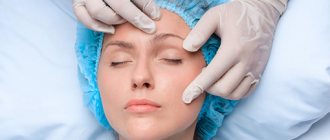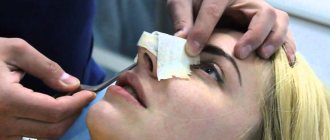After any plastic surgery, bruises and swelling occur. This is a natural reaction of the body to damage to soft tissues and blood vessels. Due to vascular injury, fluid from the bloodstream flows into the interstitial space. Accumulating there, it compresses the lymphatic vessels and venules, thereby preventing the flow of fluid into them.
Thus, primary edema increases. It takes time to dissolve. After blepharoplasty, excess interstitial fluid from the upper and lower eyelids can move to adjacent areas of the face, for example, forming swelling in the cheekbones.
Features of edema after blepharoplasty of the upper and lower eyelids
During surgery, blood vessels are damaged. This is normal and inevitable. As a result, blood enters the tissues, forming bruises. The body fights the damage and sends large amounts of plasma to protect the blood from infection. This is how swelling appears after blepharoplasty .
The severity of swelling depends on several factors:
- Individual characteristics. With thick skin, swelling is less pronounced, but takes longer to go away.
- Age of patients. In younger patients, in whom tissue regeneration occurs more quickly, recovery will not take much time.
After blepharoplasty of the upper eyelids, swelling is less noticeable, but lasts longer. The skin here is thin and sensitive.
Swelling after lower blepharoplasty extends to the zygomatic part of the face. But they go faster.
The type of access for the operation is important. After laser correction, the blood vessels are restored faster, so bruises and swelling do not linger for a long time. In a skin excision operation, the injured part will take two to three weeks to heal, and full recovery can only be observed by the end of the second month. Although you can go “in public” earlier, and the traces of the operation will not be particularly noticeable.
How to remove
An important factor in recovery is the patient’s behavior in the first days after surgery. During the first day, cold compresses are constantly applied. Cold is a factor in the constriction of blood vessels, which helps reduce the intensity of blood flow.
If you do not apply cold, then with the restoration of blood supply to the vessels, blood through damaged capillaries will begin to enter the subcutaneous tissue and skin, which will cause the formation of a large bruise.
For the first 2-3 days, it is better to sleep half-sitting or on a bed with an angle of at least 45 degrees - in this position, blood does not stagnate in the tissues of the face. And this helps reduce the severity of edema.
Blepharoplasty for Asian eyes
Blepharoplasty of Asian eyes is a type of plastic surgery, the method of which is to change the shape of the incision of the eyes, as a result of which it is possible to achieve a European-type outline.
In the postoperative period, it is necessary to reduce the emotional stress in order to avoid sudden surges in pressure - this can lead to violations of the integrity of blood vessels, especially the first 3-4 days, while the capillaries are still being restored.
Giving up bad habits in the postoperative period will only have a positive effect. The absence of alcohol in the blood allows you to reduce swelling, and when you quit smoking, the speed of recovery processes increases.
In the postoperative period, at least for several days, it is worth minimizing bending and lifting heavy objects to reduce the likelihood of capillary damage. It should be noted that for the first 10 days it is better to wash your hair by tilting it back - this is how it is washed in hairdressers.
Separately, we should mention the correction of the diet - during recovery it is better to eat light, natural food. This allows the body’s energy potential to be spent only on the recovery process.
Drug treatment
Medications are also used during postoperative rehabilitation. Their use helps to have a local effect, thereby influencing a number of postoperative conditions:
Self-medication is dangerous with complications!
Attention
Despite the fact that our articles are based on trusted sources and have been tested by practicing doctors, the same symptoms can be signs of different diseases, and the disease may not proceed according to the textbook.
Pros of seeing a doctor:
- Only a specialist will prescribe suitable medications.
- Recovery will be easier and faster.
- The doctor will monitor the course of the disease and help avoid complications.
find a doctor
Do not try to treat yourself - consult a specialist.
- anesthesia;
- strengthening blood vessels;
- softening of the skin, reducing the formation of scars;
- cooling, which promotes vasoconstriction;
- warming up, which helps increase the activity of metabolic processes, thereby reducing the severity of the bruise;
- cosmetic masking effect.
Immediately after the operation, a bandage is applied to the bandages - it protects the incision from contact with bacterial microorganisms and helps minimize the risk of complications.
How long do bruises and swelling last after blepharoplasty?
Swelling under the eyes and on the upper eyelids is noticeable for at least a week. After transconjunctival plastic surgery, bruises disappear in four days, after classical surgery - in a week and a half. But these are relative indicators. In each specific case, only a doctor will tell you when the swelling will subside, based on various factors:
- Patient's age. The older the person, the slower the tissue regeneration and, accordingly, the longer the recovery takes.
- Skin structure. On thick epidermis, swelling is less noticeable and there are not as many bruises as on thin epidermis, but recovery is slower.
- Blood circulation level. If the process is slow, it will not be possible to quickly remove bruises and swelling.
- Access method. After the transconjunctival sutureless procedure, swelling disappears completely within a week. After four days they become almost invisible.
- Site of invasion. Swelling after upper blepharoplasty disappears faster because the skin on the eyelids is thin. But it shows hematomas much more clearly.
- Infection. If during surgery or due to improper care bacteria penetrate into the inner layers of the epidermis, healing will be long and will not take place without taking antibiotics. In some cases, repeat surgery may be required.
In one eye, swelling may be more pronounced and last longer. This depends on individual characteristics due to the asymmetry of the capillaries. Infestation can also be different. If your eyelids swell unevenly after blepharoplasty, this may mean that more skin has been removed from one side.
Causes of swelling
When the integrity of body tissues is compromised, swelling may appear, this applies to even the most minor surgical interventions. During operations of any complexity, tissues are damaged, so the body begins to react to this, which leads to the formation of swelling.
Edema is accumulated fluid in the tissues of a particular organ, and can sometimes collect in the space between the tissues. All edema can be divided into local and general.
The result of surgical interventions is usually local swelling. Very often, after surgery, serious disturbances occur in the body and it is injured.
This leads to a strong flow of lymph to those areas where the tissue has been damaged. The reason for the accumulation of lymph is the enhanced functioning of the human immune system, which helps the body maintain its normal state, despite surgical interventions.
Less common are swelling after surgery, which is caused by inflammatory processes. Edema of this type can be distinguished by the increased temperature of the skin in places of swelling, in addition, they acquire a reddish tint.
There can be a huge number of reasons for the appearance of edema. This sign can even be a symptom of a dangerous disease, so it would be a good idea to get examined and consult a doctor if your face swells quite often.
The following popular reasons can be identified:
- Fluid accumulation. The most common cause of edema is drinking large amounts of liquid at night or eating salty foods. Also, the face may swell after drinking too much alcohol or after crying.
- The appearance of inflammation. If this happens, then the skin will also turn red and the temperature may rise.
- Diseases of internal organs. Often people with problems with the heart, kidneys, or thyroid gland suffer from swelling.
- Allergic manifestation. In this case, swelling may appear quickly and disappear in a short period of time.
- Hormonal imbalances, injuries, insect bites.
- Genetic predisposition to the formation of bags under the eyes.
- Tired eyes. People who work at a computer for a long time strain their eyesight and may experience swelling.
- Age. Over the years, the skin loses its tone, so sagging tissue appears in this area. This problem is also common in people over 40 years of age. This is due to the anatomical structure and loss of skin elasticity.
First of all, the cause of edematous eyelids is the accumulation of interstitial fluid and its retention due to metabolic disorders.
In order to deal with a problem, it is first necessary to find out the cause of its occurrence, because this is the only way to choose the most acceptable and effective way to combat it.
It is worth consulting a doctor and ruling out all possible diseases that can also cause edema - hormonal imbalances, liver and kidney pathologies, cardiovascular diseases.
The appearance of edema can be caused by a variety of reasons. Here are some of them.
Lifestyle
Needless to say, even lifestyle can affect your appearance. If you are a fan of noisy alcoholic parties, go to bed in the morning and wake up only in the evening - problems with edema simply cannot be avoided.
How to remove swelling after drinking? It is simply not possible to quickly cope with the problem - excess fluid and lack of sleep will leave their mark on the face in any case.
Here it is best to immediately use special cooling creams and drink a diuretic to remove fluid more quickly.
Exposure to bright light on the eyes and excessive exposure to ultraviolet radiation also have a negative effect.
In all these cases, you just need to reconsider your lifestyle, eliminate alcohol and other harmful substances, and go to bed on time.
All this will help maintain beauty and radiant appearance for a long time.
Sometimes crying is useful, because some harmful substances are removed with tears. But everything should be in moderation, so tears, especially at night, can cause swelling on the face in the morning.
This happens because tears contain salt, which prevents the removal of fluid, it accumulates and excessive swelling appears. Moreover, tears are often associated with stress and emotional experience, insomnia.
All these factors naturally have a negative effect on the body, so you should try to avoid such conditions.
Cosmetical tools
Excess cosmetics always negatively affects the condition of the skin, even if the products are of good quality and from reputable manufacturers.
Before going to bed, remnants of cosmetics must be carefully removed, otherwise there is every risk of harming not only the skin, but the entire body.
Getting cosmetics into the mucous membrane of the eye is dangerous and the appearance of swelling after this is the least problem that can happen.
Swelling can form both after surgery and with any damage to the integrity of body tissues. However, after surgery, the damage is usually quite severe, so the body's reaction is severe tissue swelling.
Edema is the accumulation of fluid in body tissues or between tissue spaces. After surgery, local edema is predominantly formed, caused by the influx of lymph to the destroyed tissues.
The cause of postoperative edema is the active work of the immune system, the functioning of which is aimed at maintaining the normal state of the body after destruction of its integrity.
In some cases, the cause of swelling after surgery is inflammatory processes that progress in the human body. In such a situation, there is a rise in body temperature and the skin turns red. The severity of swelling after surgery may be insignificant, or, conversely, quite pronounced. This is determined by the following factors:
It is necessary to relieve swelling after surgery as soon as possible, and there are no preventive measures against such an unpleasant phenomenon. In order to speed up the patient’s recovery after surgery, it is necessary to follow all the doctor’s recommendations and refrain from self-medication.
Most often, swelling appears 2-3 days after surgery and begins to decrease over time. How long it takes for the swelling to subside after surgery depends both on the complexity of the surgical intervention and the individual characteristics of the body.
If swelling persists for a long time, it is necessary to seek help from a qualified specialist who will identify the causes of this pathological condition and prescribe the necessary treatment.
If swelling of the face becomes an everyday occurrence, then you should not put off visiting a doctor to find out the cause.
Causes of facial swelling:
- excessive fluid intake during the day;
- eating disorder;
- bad habits;
- hormonal imbalances;
- genetic predisposition;
- diseases of internal organs;
- age-related changes.
A visit to the doctor will help determine exactly the cause that causes swelling of the face and choose treatment for this symptom.
However, if a visit to a therapist is not part of your plans, then there are several ways to get rid of facial swelling at home.
How to relieve swelling after blepharoplasty with medications
Swelling and hematoma after surgery only increase in the first two days. At the same time, the eyelids itch because the incision line is healing. To prevent tissue infection, the doctor prescribes antibiotics. To eliminate discomfort associated with itching, bruising and swelling - ointments: Hydrocortisone, Lokoid, Liaton, Traumeel, Sinyakoff. The main thing is that the patient is not allergic to the components of the medications, otherwise the swelling will become even worse.
Ointment for bruises should be applied once or twice a day, without stretching the skin of the eyelids and without getting on the mucous membrane. The course of treatment is one week.
Additionally, from the first day you can take Traumeel tablets for puffiness under the eyes after blepharoplasty. They consist of plant components and have a diverse effect, significantly improving the condition.
Rehabilitation after facial plastic surgery
Rehabilitation after a facelift (facelift), liposculpture and blepharoplasty is individual, but as practice shows, tissue restoration takes 2-3 weeks
.
During this period, bruises
and slight
swelling
, which increases
2-3 days
after surgery.
Pain usually does not bother you and does not interrupt you from rest and daily activities; it can be reduced with the help of mild painkillers prescribed by your plastic surgeon. There is no need to worry about scars after a facelift and blepharoplasty - they are hidden in the natural folds of the skin or under the hair, and over time they will become invisible. If, during recovery after facial plastic surgery, a patient has an individual tendency towards hypertrophic, keloid, atrophic scars or the tissue healing process does not go entirely smoothly, cryodestruction of the scar, lipofilling or injection cosmetology comes to the rescue. Plastic surgeons at the Pirogov Clinic are always in touch with their patients. The key to successful recovery after facial plastic surgery is to follow all the doctor’s recommendations: for a while you need to give up warm baths, solariums, alcohol and smoking.
Traditional recipes for swelling after blepharoplasty
Herbal preparations are famous for their anti-inflammatory and disinfecting effects. relieve swelling and bruises after blepharoplasty . Sterile cotton pads should be dipped in the strained liquid, squeezed lightly and applied to the eyes for 15 minutes. Do the procedure 3 times a day.
It is better to prepare an infusion from one component to observe the skin reaction. Herbs can trigger allergies, which can cause increased itching.
You can use grated raw potatoes or finely chopped parsley as an applicator.
Since the body's reaction to the components may vary, an ophthalmologist's approval should be obtained for the procedure.
Postoperative problems
Limit the use of hot water. After the operation, you are not allowed to take a hot bath or shower, and you will also have to avoid washing your face with too warm water.
A contrast shower is considered an effective remedy, thanks to which it is possible to free the tissues from the accumulation of fluid. After surgery, you are not allowed to be outdoors for a long time, as this may cause increased swelling.
- Using cold compresses. A few days after surgery, it is recommended to apply cold compresses to the face or certain areas of it for several hours. As an alternative, chilled cabbage leaves can be used to relieve swelling after surgery.
- Complete nutrition. In the postoperative period, it is necessary to exclude from the patient’s diet those foods that can provoke tissue swelling. It is not allowed to consume large amounts of liquid or eat salty foods at night. You will have to stop drinking alcoholic beverages, as they impair blood circulation and thereby cause increased swelling.
- Control of physical activity. After surgery, it is necessary to avoid any physical and emotional stress on the body. The fact is that any stress or severe fatigue can provoke a further increase in swelling.
- Rest and peace. After surgery, you need to take care of proper rest and complete peace. It is important to remember to keep your head slightly elevated while sleeping. In addition, you need to avoid facial tension and avoid training in the gym. Morning jogging and other types of physical activity will have to be postponed for some time.
If it is not possible to get rid of postoperative swelling of the soft tissues of the face, you should consult a specialist. It may be that to solve this problem, additional exercises or massages will be required to reduce swelling.
To eliminate the pathology, a specialist may prescribe diuretics to remove fluid accumulated in the body. In advanced cases, hormonal drugs can be used, but under the supervision of a doctor.
You can get rid of tissue swelling after surgery using both conservative therapy and folk remedies. It must be remembered that resorting to such recipes is permitted after consultation with a specialist.
You can relieve swelling of the lower extremities using the following means:
- use infusions of chamomile or St. John's wort;
- rub the inflamed areas of the skin with valerian tincture;
- rub olive oil into swollen tissues;
- apply vinegar compresses.
You can quickly get rid of post-operative facial swelling at home using proven methods:
- wipe the entire face or individual areas with a piece of ice, which is prepared from tea or chamomile infusion;
- make a face mask by brewing a few tablespoons of green tea and wipe the inflamed tissue with the resulting solution;
- Cucumber or raw potatoes help relieve postoperative swelling.
Swelling after surgery does not pose a serious threat to human health and life. However, it is necessary to quickly get rid of this problem, which will prevent the development of dangerous complications in the future. Before removing swelling after surgery, you should consult a specialist.
The causes of swelling can be facial surgeries that are therapeutic or cosmetic in nature.
The most common surgeries are dental and nose reshaping.
Cosmetical tools
Non-medical creams should only be used after injured tissue has healed. The action of cosmetics is based on improving tissue regeneration and skin cell renewal.
Cream with retinol is good for removing puffiness under the eyes. Creams with lingzhi and shiitake mushroom extract have a high restorative ability. But you can use cosmetics only after approval from your doctor.
Additional recommendations
After blepharoplasty, bruises under the eyes will go away faster if all the conditions of the rehabilitation period are met:
- sleep only on your back with pillows raised high;
- do not lower your head down, even tilt it back when washing;
- do not watch TV, do not read;
- protect your eyes from bright light with dark glasses;
- try to blink less;
- do not drink alcohol, stop smoking if possible;
- Salt dishes less, eliminate hot seasonings;
- drink 1.5 liters of water per day;
- do not perform physical activity;
- apply cold compresses on the first day;
- Do not touch your eyes with your hands, except for mandatory procedures.
An unpleasant consequence of blapharoplasty is swelling of the eyelids and eyes. Causes, types, methods of treatment
When there is excess skin in the eye area, today we offer plastic surgery – eyelid blepharoplasty.
The procedure is quite simple, but some complications may arise during the rehabilitation period. By following the recommendations of doctors, you can quickly get rid of them. We'll tell you when to expect the swelling to subside and what actions you can take to speed up this process.
If bruises and swelling do not go away after blepharoplasty
Prolonged healing and pronounced signs of surgery require diagnosis. If swelling does not go away for a long time after plastic surgery, you should go for an unscheduled examination. Depending on the general condition, the doctor will prescribe one of the methods:
- In the absence of serious complications, use medications and cosmetics. After some time, the swelling goes away on its own.
- For severe headaches and blurred vision, you may need to take medications in combination with physical therapy.
- If the hematoma does not resolve for a long time, the surgeon spreads the edges of the incision and removes the blood clot. The vessel may need to be sutured.
The most dangerous thing is that after blepharoplasty, prolonged swelling may indicate such serious consequences as:
- Infections. Tissue infection can begin during surgery if sterility is not maintained or during rehabilitation, which is more likely. The infection causes redness of the skin and additional swelling. The doctor decides how to remove it individually. In most cases, antibiotic therapy and antiseptic treatment are prescribed.
- Inverted eye effect. Occurs due to excessive removal of skin on the lower eyelid. In this case, a massage, additional sutures or repeated surgery may be prescribed.
- Retrobulbar hematoma. A complication occurs if a large vessel is affected and blood clots appear behind the retina. In this case, redness and persistent swelling are accompanied by pain when rotating the eye sockets. An additional operation solves the problem.
If you respond correctly to your condition and follow general recommendations, swelling will go away quickly. Blepharoplasty is not a complex operation and rarely causes complications.
Late risks with photos
Read the description and photos of possible negative consequences of the operation, which include the formation of bumps, scars, scars, as well as different or round eyes, hernias and other side effects.
Seals, bumps, knots, balls
The formation of various compactions, lumps, and nodules can be the result of improper treatment of hematomas. Repeated consultation with a specialist is necessary. This complication is quite common after blepharoplasty.
Blepharoptosis
Blepharoptosis is a sagging of the upper eyelid that occurs as a result of damage to a branch of the nerve during surgery. Restoration of the integrity of the nerve and innervation of the corresponding muscles occurs within 1-2 months after surgery. In some cases, repeated intervention is required.
Lagophthalmos
Lagophthalmos is an ophthalmological pathology in which the normal process of closing the eyelids is disrupted. The cause of the defect is excessive removal of the skin. If the eyes do not close, the normal process of moistening the cornea is disrupted, the result is a decrease in its transparency with subsequent loss of vision. Treatment is repeated surgery.
Why does seams come apart and what to do about it?
The cause of this complication may be a violation of the suturing technique, severe swelling, or infection. The defect is eliminated by repeated suturing; in case of infection, antibiotic therapy is necessary.
Can colloidal scars and scars remain and how to avoid pathology?
Normally, scars resolve within 3-5 months after surgery. In some cases, the formation of rough or keloid scars occurs. The reasons for their occurrence include:
- individual characteristics of the body;
- violation of suturing technique;
- divergence of seams.
Tearing
Why did my eyes start to water and what should I do about it? This unfavorable consequence is due to a change in the localization of the lacrimal openings (their displacement) or a disruption of the normal outflow of tear fluid, which arose during tissue scarring. Treatment is surgical.
Round eye
This complication is characterized by a change in the shape of the palpebral fissure. It manifests itself as dry conjunctiva, excessive lacrimation, and hyperemia. Treatment is repeated surgery.
Cyst
A cyst is a formation limited to a capsule and containing contents. Formed at the tissue cut line. They may disappear on their own after 2-3 months; in some cases, they require opening and removal.
Different eye sizes
It happens that one eye becomes smaller than the other as a result of surgery: is this normal? Changes in the shape and size of the palpebral fissure occur due to excessive tissue removal. The consequences can be various ophthalmological pathologies. Treatment is surgical.
Drooping of the upper eyelid
Drooping eyelid is blepharoptosis. The reasons for its formation, clinical manifestations, and treatment are similar to those for blepharoptosis.
Keratoconjunctivitis: what is it and how to get rid of the problem?
Keratoconjunctivitis is an inflammatory process localized in the conjunctiva and cornea of the eye. Is an individual response to intervention. Treatment - antibacterial agents, agents that normalize the condition of the mucous membrane of the eye.
The feeling of heaviness does not go away
A feeling of heaviness in the eye may be a consequence of the formation of a hematoma or the development of an infectious and inflammatory process. Treatment depends on the cause of this manifestation.
Soreness
Soreness of the eyelids occurs in response to trauma to tissue structures. Treatment consists of prescribing painkillers. If pain persists for a long time, even a month after surgery, a doctor’s consultation is necessary.
Itching
Sometimes patients complain that their eyes itch. This manifestation occurs due to dryness of the mucous membranes of the organ of vision. The reasons may be varied. Treatment depends on the cause of this manifestation.
Dips
The formation of hollows under the eyes is a consequence of excessive removal of fatty hernias of the eyelids. Correction requires lipofilling (injection of adipose tissue into the eyelid area).











